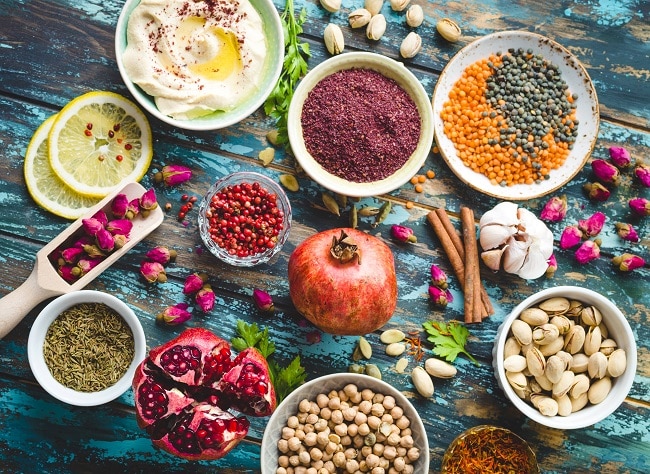In a rut with food? If you’re tired of using the same old spices, condiments and techniques to make your meals, it may be time to try something different. There are worlds upon worlds of spices that you can tap into, such as the gamut of Middle Eastern spices, many of which still fly under the radar in the U.S
Now is a great time to start incorporating the zest and vigor of this cuisine into your usual go-to recipes. As a base, use your favorite recipes for meats, vegetables and grains and simply flavor them with something exotic and delicious to give your stand-bys new life.
1. Sumac
The sumac bush, native to the Middle East, produces deep red berries, which are dried and ground into coarse powder. Think of of sumac as “Persian MSG.” It’s salty and lemony, a natural way to set off other flavors. It’s one of the many ingredients used in Persian cooking to give food a tart flavor. Use it anywhere you would lemon juice.
Try: Use it in salads instead of lemon or sprinkled over hummus, or to jazz up a bowl of humdrum lentil soup.
2. Pomegranate molasses
Pomegranate molasses is just pomegranate juice reduced to a thick, sweet-tart syrup. Tangy but not overly sweet, it’s an extremely versatile addition to your condiment repertoire. Use it in place of citrus juice or vinegar in salad dressings or treat it as a glaze on meats before grilling or roasting.
Try: Mix with olive oil and drizzle over roasted vegetables. The acidity adds zing to the earthy root vegetables.
3. Dukkah
This Egyptian condiment is a mix of nuts, seeds and spices that get ground into small bits. It’s especially tasty on popcorn and salads and sprinkled on dips. Dukkah can also be easily made at home—just blend coarsely chopped toasted nuts, such as hazelnuts or pistachios, toasted sesame seeds, cumin seeds, coriander seeds and salt.
Of course, dukkah was made for riffing. Go ahead and experiment with a teaspoon or two of other spices, toasted seeds, or dried herbs. Fennels seeds, caraway seeds, dried mint or thyme, red pepper flakes and cinnamon all work, too.
Try: On eggs of any kind—poached, fried or scrambled—dukkah improves them all. Just throw a healthy handful on top before serving.
4. Baharat
A warming, finely ground spice mixture made with paprika, black pepper, cinnamon, coriander, cumin and cardamom, this all-purpose spice blend literally means “spice” in Arabic. It has a big flavor pay off, adding depth and complexity to anything it adorns. Baharat is to Middle Eastern cuisine as garam masala is to Indian food; a ubiquitous seasoning considered indispensable to most dishes.
Try: Don’t worry about it being too hot. Its gift is in its aromatic signature along with the ability to add zest to any dish—especially, rice, lentil and pilaf dishes.
5. Dried limes
Essentially small limes that have been boiled in salt brine and left to dry until they’re rock hard, dried limes are a staple of Iranian cooking. But unlike with fresh limes, you can’t just squeeze the juice or grate the peels. These citrus flavor bombs can be used one of two ways: whole or powdered. Add whole dried limes to the cooking liquid for rice or stock for a soup. Or sprinkle pulverized dried limes onto rice or grain salads or add it to a marinade for chicken or fish. The dried limes have a slightly fermented, smoky taste that add a refreshing sour taste to dishes.
Try: As a rub for seafood, it gives fish an unusual vibrancy.

